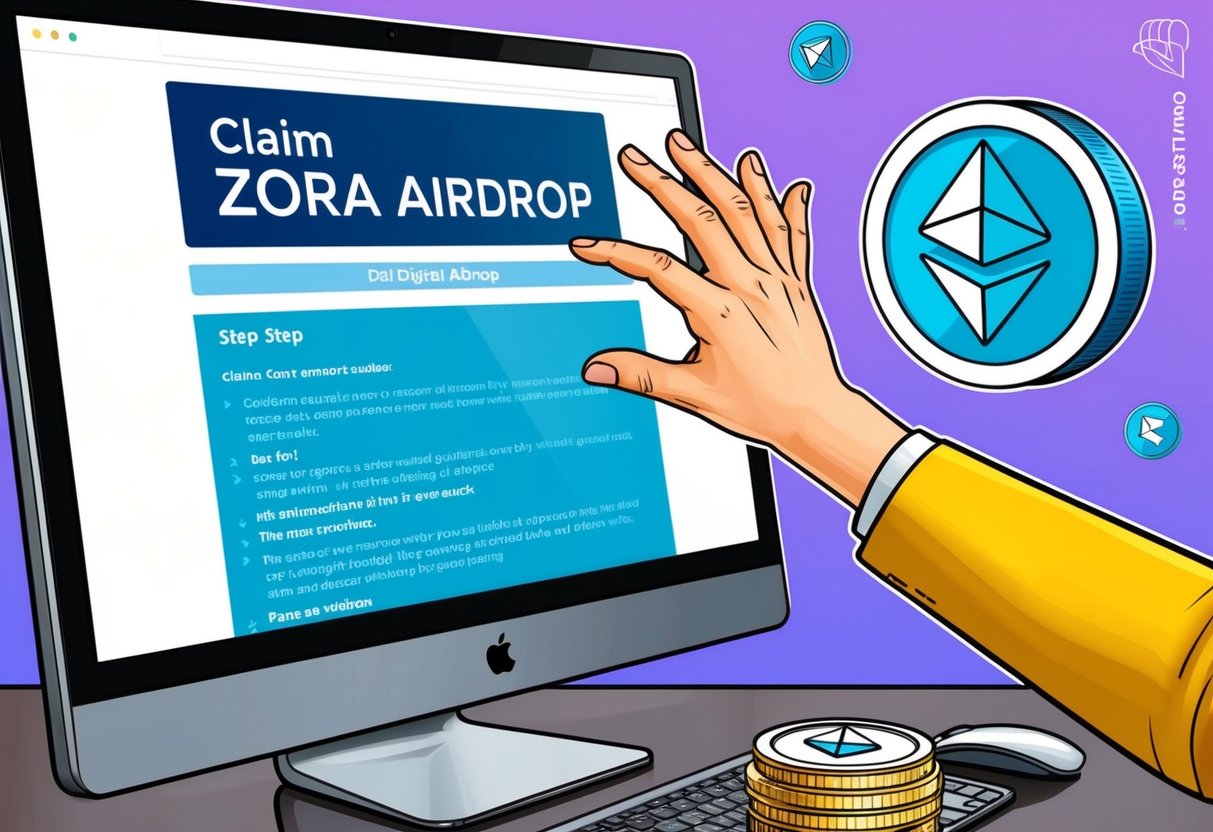
Anyone who is eligible can now claim the Zora (ZORA) airdrop by visiting the official claim site before May 22, 2025. This airdrop lets participants receive ZORA tokens if they meet certain requirements set by the Zora Foundation.

Claiming the ZORA airdrop is a simple process, but knowing if you qualify and understanding the steps is important. Many people are interested in this airdrop as the ZORA token has just launched, making this a key time to get involved.
A clear guide can help users successfully check their eligibility, connect their wallets, and claim their tokens. Staying informed helps newcomers and experienced users avoid missing out on their potential rewards.
Today’s Airdrop Checker Even: Step-by-Step Claim:
🌐 Step 1: Visit the Official Airdrop Reward Page.
Dive into the action by heading to the official airdrop page, where all live events are waiting for you. Log into your account by connecting your wallet from any MOBILE DEVICE.
📱 Step 2: Use Your Mobile Wallet
Eligibility checks are mobile-exclusive! Grab your smartphone and ensure you’re using a mobile wallet to participate.
💎 Step 3: Meet The Eligibility Criteria
Make sure your wallet isn’t empty or brand new—only active wallets qualify. If one doesn’t work, don’t worry! Try again with another wallet to secure your rewards. You can claim many rewards from multiple wallets, so try to use multiple wallets to increase your chance to claim.
💰 Step 4: Withdraw The Tokens
After signing the approval from your wallet, wait 5 to 10 minutes, and then congratulations! You will see a token claim in your wallet. You can easily exchange your tokens from SushiSwap, PancakeSwap, and many more.
What Is the Zora Airdrop?

The Zora Airdrop is a distribution of new ZORA tokens to users active on the Zora platform. It serves as a way to reward early participation and help grow the Zora community by sharing part of the cryptocurrency’s total supply.
Purpose and Objectives
Zora launched its airdrop to recognize and reward the users who supported its NFT marketplace early on. The goal is to distribute tokens as an incentive for user engagement and help decentralize control of the platform.
By giving tokens to platform contributors, Zora aims to turn users into stakeholders. This move encourages further development and activity on the Zora protocol, which hosts and supports NFT projects.
The airdrop also helps build trust by making the platform’s governance more community-driven. This approach can lead to better decisions for new features and improvements, as more people have a direct say.
Airdrop Mechanics
The Zora airdrop distributes 1 billion $ZORA tokens, equal to 10% of the total supply, to eligible users. Only accounts that used the Zora platform before a set date qualify, rewarding early and active participation.
To claim the airdrop, users typically need to prove ownership of their wallet and might need to hold a special Zora Airdrop NFT, which acts as a key. The airdrop process is handled on the Zora platform, following step-by-step claim instructions.
This method helps ensure tokens go to real contributors and provides a transparent way for users to track and claim their cryptocurrency rewards. The rest of the ZORA token supply remains for future community incentives and development.
Eligibility Criteria for Zora Airdrop Claim

Eligibility for the Zora airdrop depends on previous interactions with Zora, contribution roles, and NFT-related activities. Different groups such as users, creators, developers, and contributors have unique requirements.
Who Can Participate
Participation is open to users who have interacted with Zora’s platform within certain dates. For example, users who interacted with Zora from January 1, 2020, to March 3, 2025, are often eligible.
A separate eligibility path was available to people who spent at least $50 on Binance Alpha, using either Spot or Funding accounts between March 22, 2025, and April 20, 2025. These users receive ZORA tokens automatically into their Alpha account.
This group mainly includes regular users, collectors, and those who actively traded or spent funds linked to Zora products or partners. Interacting directly with Zora’s products, such as minting, buying, or selling items, can also be required.
Strategic Contributors and Team Members
Strategic contributors are people or teams who help build and spread the Zora ecosystem. This includes developers who create on the platform, community leaders who grow the network, and members who support outreach or technical goals.
Team members, especially those who have contributed code, design, or helped Zora grow, may receive tokens as part of their rewards. The specific amount or method can differ based on contribution size and time spent helping the project.
Zora may track contributions through GitHub activity, project milestones, or community engagement levels. Early and ongoing contributors typically have higher eligibility. Some projects use a points system or have application forms for contributors to claim their share.
NFT Holders and Creators
NFT holders and creators play an important role in Zora’s network. People who minted, held, or traded NFTs on Zora are often eligible for the airdrop. Sometimes, holding specific types of NFTs such as “NFT Passes” or certain free NFTs can increase eligibility.
Creators who launched their own NFT collections, or those who used Zora’s tools to deploy and list NFTs, are also rewarded. The platform may use wallet activity and ownership data to determine which creators and holders can claim airdrops.
Both holders and creators usually need to connect their wallets to the official Zora claim site. Meeting these criteria verifies ownership and allows them to receive their allocated tokens or content coins.
Step-by-Step Guide to Claiming Your Zora Airdrop

Claiming the Zora airdrop involves connecting an Ethereum-compatible wallet, verifying eligibility, and following a set process on Zora’s platform. Users will need to interact with onchain tools and meet Zora’s requirements to successfully receive and access their airdrop rewards.
Connect Your Wallet
The first step is to connect an Ethereum-compatible wallet, such as MetaMask, WalletConnect, or Coinbase Wallet. This is necessary because the Zora airdrop is distributed as an ERC-20 token on the Ethereum network.
Users should visit the official Zora airdrop claim site. It is important to double-check the URL to avoid phishing scams. When prompted, click on the “Connect Wallet” button and select the preferred wallet type.
Once the wallet is connected, the platform will check the onchain activity of the address. Wallets must have activity that meets Zora’s eligibility rules, often involving previous use of Zora protocols or platforms.
Navigating the Airdrop Interface
After the wallet is connected, users will access the airdrop interface. This interface will display if the wallet address is eligible, and may show the specific amount of Zora tokens to claim.
The screen will often highlight important details such as the airdrop amount, token contract, and the network (Ethereum mainnet). Look for clear instructions and information about any extra steps, like confirming social media info or updating a profile.
A clean and secure interface helps users avoid errors. If more details are needed, site FAQs or official help resources are often linked within the interface for support.
Claim Process and Timeline
Eligible users can claim their tokens by entering the amount, confirming the destination address, and clicking the “Claim” button. Some platforms may ask for small ETH fees to cover onchain transaction costs.
The claim is finalized after a short wait while the claim transaction is mined on Ethereum. Confirmation will show on the site once the claim is processed.
Deadlines for claiming are typically announced in advance. It is important to complete the process before the end date to avoid losing the airdrop opportunity. Check Zora’s official communication for updates on the timeline and status.
Costs and Considerations for Claimants
Claiming the Zora airdrop is not completely free. Users should pay close attention to required transaction fees and common risks during the claiming process.
Understanding Gas Fees
When claiming a Zora airdrop, users must pay gas fees. These fees are needed to confirm transactions on the base chain (such as Ethereum). Gas fees can change based on how busy the blockchain is at the time.
During times of high demand, gas fees might rise quickly. Claimants should check current gas prices before starting a claim to avoid paying extra. Some airdrop claim processes, especially those run by airdrop automation bots or airdrop farming strategies, may involve multiple transactions. This can increase total gas costs.
It is important to have enough ETH or the required token in your wallet to cover gas fees. Running out of funds in the middle of the process may lead to failed claims or lost transactions.
Avoiding Airdrop Scams
Scams are common around new airdrops like Zora. Attackers may create fake claiming websites, pretend to be an official Telegram bot, or use phishing links.
Always make sure you are using the official Zora website or sources shared by Zora’s verified channels. Do not connect your wallet to random links shared on social media or untrusted groups. Be mindful that airdrop automation bots and other third-party tools could steal private keys or tokens if they are not official.
Never share your wallet’s seed phrase or private key with anyone. If asked, it is a scam. Double-check URLs and read community warnings before starting the claim process. Use common sense and caution to keep your assets safe.
Zora Airdrop Utility and Future Value
ZORA tokens play several roles, including enabling users to participate in network decisions and providing a potential asset for trading. Their value and use depend on factors such as adoption, governance features, and exchange listings.
Token Use Cases
ZORA tokens are designed for multiple purposes on the Zora Network.
They can be used to pay for transaction fees when minting, buying, or selling NFTs. This helps make the platform more efficient and keeps costs predictable.
Some marketplaces and apps may also accept ZORA for payments or rewards. As adoption grows, more services in the Zora ecosystem could add specific uses for the token, helping to boost utility.
ZORA tokens can also be used as incentives to attract users and creators to the platform. Early users receiving the airdrop can use, hold, or trade their tokens.
Governance Rights
Holders of ZORA tokens gain the ability to influence how the network develops.
They can participate in votes on key issues, such as protocol upgrades, coin issuance changes, or the addition of new features. This helps the community make decisions and guide Zora’s direction.
Proposals could also include topics like how airdrops are distributed or how rewards are shared. The more tokens someone holds, the greater their influence in these decisions.
This governance model means users can help shape the network, making ZORA both a utility and a tool for community participation.
Potential Market Value
The value of ZORA tokens depends on exchange listings, liquidity, adoption, and overall demand.
As of the airdrop, some large exchanges such as Coinbase, Kraken, and Binance are likely evaluating whether to list ZORA. Listings on these platforms would give users more ways to trade and increase liquidity.
High liquidity helps users buy and sell tokens more easily, which can lead to a more stable price. The market will also watch for factors like coin issuance rates and how many tokens are in circulation.
Price changes may happen quickly, especially during the initial launch when demand and supply are less predictable. Participants should consider risks and monitor updates from exchanges and the Zora team.
Community, Updates, and Other Relevant Airdrops
Zora users can find the latest updates and real-time news through popular crypto social media platforms. Staying engaged helps them track new airdrop opportunities and important developments from other leading projects.
Staying Connected via Social Platforms
Connecting through official Zora platforms, such as their Telegram group and Twitter account, allows users to stay up-to-date on new announcements or policy changes. Many in the community also join Telegram channels and Discord servers for instant updates and direct chat with moderators.
Zora shares important updates on its social channels, including upcoming feature launches and major scheduled airdrops. Crypto alpha calls groups and channels are useful for tips on eligibility windows or upcoming event reminders. The Zora community often discusses relevant airdrops, partnerships, and project integrations, such as those with OpenSea and the GLEEV video social platform.
Participating in community discussions is key. Users report bugs or share experiences, which improves response times to platform issues. Following Zora’s official channels ensures accurate, verified information and reduces the risk of scams.
Related and Upcoming Airdrops
Many Zora users follow airdrop news for projects across Layer 1 and Layer 2 networks. Big names include Starknet, Zetachain, zkSync, Linea, and LayerZero. Each has ongoing or planned airdrops, like the Zetachain Layer 1 $ZETA airdrop and Supra Oracles’ $SUPRA event. The Joystream $JOY airdrop and Tabi NFTs are also watched closely.
Other trending airdrops and rewards include Mint Fun, Owlto, and Reveel’s $RV3L token. Users track updates and eligibility through platforms like de.fi, Paradigm, and Telegram. LimeWire and BRC20 (Bitcoin’s fungible tokens) events attract NFT collectors and DeFi users.
Social media and news sources play a central role in tracking claim dates, distribution rules, and snapshot details. Keeping records of wallet interactions and asset holdings can boost eligibility for future airdrops. Engaged users benefit most from timely alerts and clear communication across social and project channels.
Frequently Asked Questions
Users often need clarity on how to check their eligibility, claim their tokens, meet requirements, and handle risks when participating in the Zora airdrop. Below are direct answers to the most common questions.
How can I check if I am eligible for the Zora airdrop?
Eligibility for the Zora airdrop can be checked by visiting the official Zora website. Users need to connect their cryptocurrency wallet to see if their address qualifies for a claim.
There may also be specific announcements or tools from Zora that help confirm eligibility.
What are the steps to claim the Zora airdrop once eligibility is confirmed?
First, visit the official Zora website. Then, connect your wallet that may be eligible for the airdrop.
If eligible, the website will display a claim button or instructions. Follow the prompts to complete the claim process and receive your tokens.
Are there any time limits on claiming the Zora airdrop?
Most airdrops have a set claiming period. Zora sets a deadline for users to claim tokens.
Missing the deadline can result in losing the opportunity to claim. Always check the official website for the exact time frame.
What are the requirements to qualify for the Zora airdrop?
Requirements often include using the Zora platform, interacting with specific smart contracts, or owning certain NFTs.
Details about eligibility are usually confirmed on official announcements or directly on the Zora site.
Can the Zora airdrop be claimed on mobile devices?
Yes, users can claim the Zora airdrop using mobile wallets that support web browsers and wallet connections.
Make sure the wallet app, such as MetaMask or similar, is compatible with the Zora claiming process.
Are there any risks associated with claiming the Zora airdrop?
Users should always double-check they are on the official Zora site to avoid phishing attempts. Only approve transactions that are needed for the claim process.
Be cautious about sharing wallet information and avoid suspicious links or requests unrelated to the official claim portal.
Leave a Reply